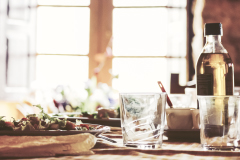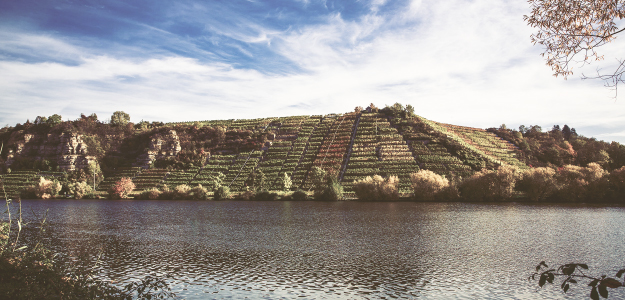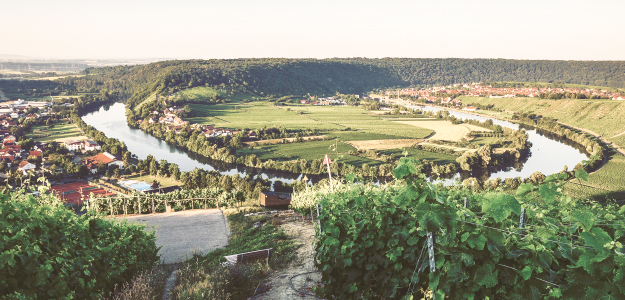OUR GRAPE VARIETIES
PLEASE CHOOSE:
ACOLON
The new trendy red wine variety is without doubt Acolon, a Württemberger original. It comes from a cross between the two varieties Lemberger and Dornfelder. Its deep blue grapes are used to make powerful red wines with a deep dark colour and subtle tannins, as well as brightly coloured rosé wines. The extract-rich Lauffener Acolon is largely refined through traditional vinification with mash fermentation and ageing in oak barrels. It is characterised by a long shelf life. Its fine fruit flavours are reminiscent of raspberries and sour cherries in rosés and dark stone fruit with a fine spiciness in red wines.
GEWÜRZTRAMINER
Gewürztraminer is a white grape variety that produces flavoursome, full-bodied wines that are rightly counted among the top wines and often reach Beerenauslese level. Only the best sites are worthy of this very old grape variety. Its grapes produce wines that are praised for their golden yellow colour and extremely fine, fruity bouquet.
GRAUBURGUNDER
The highly ripe grapes of the Burgundy grape growing on warm and deep soils are the basis for expressive white wines. Pinot Gris is one of the best varieties in our local vineyards. Its wines are powerful, full-bodied and creamy, with a dense bouquet of green and yellow pears, meadow flowers, herbs and fine fresh butter. Matured in barriques, the Pinot Gris develops astonishing complexity and fullness.
KERNER
This native Lauffen white wine grape variety, which is the result of crossing the Trollinger and Riesling vines, reaches a high level of natural ripeness. It is the Prädikat wine supplier par excellence: powerful in body and with fine acidity. These are wines with a savoury character, with a fine, Riesling-like fruit acidity and an aroma of tropical fruit and ice candy.
LEMBERGER
Also known as Blaufränkisch in Austria, it is a highly demanding red wine grape variety in terms of location, climate and soil. It is therefore only cultivated to a limited extent, in Germany almost exclusively in Württemberg. Thanks to its deep dark colour, powerful body and tangy character, its wines are among the world’s red wine elite and are ambassadors for Württemberg’s premium wines.
MÜLLER-THURGAU
This popular white grape variety ripens early and thrives on deep, nutrient-rich soils. Müller-Thurgau is best drunk young. It is delicate and fragrant, yet expressive in flavour, with a light muscat tone and low acidity. Its wines tend to be light and floral, with a subtle bouquet of fresh apples and green peppers.
MUSKATELLER
The high-quality Muskateller is probably one of the oldest grape varieties of all, which is why there are over 200 different Muskateller varieties today. In Württemberg, it is mainly the yellow Muskateller that is cultivated. In most cases, the yellow-green Muskateller is pressed as a flowery white wine with a great aroma of orange blossom and sweet tendencies. Many wines have a spicy muscat bouquet.
MUSKATTROLLINGER
Originally grown as a very aromatic table grape, Muskattrollinger is now a speciality with a distinct nutmeg note. Muskattrollinger is characterised not only by its intense but not intrusive nutmeg bouquet, but also by the bright ruby red colour and fruitiness of the Trollinger.
RIESLING
Riesling is the queen among Germany’s white wine grape varieties. It is demanding, ripens late and produces elegant, lively wines with a fine fruity bouquet of apples and yellow stone fruit, with delicate acidity and freshness on the heavy Keuper and shell limestone soils of Lauffen and Mundelsheim.
SAMTROT
Every year, this red grape variety produces fine wines with a delicate, cherry-like bouquet and elegant fullness on the palate. As a mutation of the Schwarzriesling, the Samtrot lives up to its name with its bright ruby red colour and velvety body.
SCHWARZRIESLING
Schwarzriesling is often referred to as the forefather of the Burgundy family, as it was frequently involved in cross-breeding. The grapes achieve high Öchsle levels even after a short ripening period, even at medium altitudes. It owes its name Pinot Meunier (Meunier = miller) to the fact that the underside of the very hairy leaves and the tips of the shoots appear to be dusted with flour. This is why it is also called Müllerrebe in Germany. Schwarzriesling is the flagship grape variety of the Lauffener Weingärtner.
The similarity of the grape shape to Riesling and its dark colour gave this variety its name. The colourful, ruby-red wines with brick-red reflections are characterised by a delicate dark berry aroma of blackberries, blueberries and black cherries, with a fine peppery spiciness and a fruity, silky smooth body.
SPÄTBURGUNDER
Pinot Noir is considered to be one of the highest quality and most important red wine grape varieties in the world. Together with Riesling, Pinot Noir represents the premium league of German wine. Due to its late grape ripening, it reacts particularly sensitively to the location and microclimate and therefore requires a great deal of sensitivity. For elegant wines, it requires warm vineyard sites with deep, loose, fertile soils in cool growing regions.
The multi-layered flavour of Pinot Noir includes red and black cherries, blackberries and plums, with spicy nuances. Thanks to its fine-grained tannin with delicate bitter notes, which make its wines so savoury, and its mild acidity, it glides smoothly and freshly over the tongue. Pinot Noir wines can be drunk young, but they are also suitable for ageing with high-quality wines.
TROLLINGER
Thanks to its emphasised acidity, Trollinger produces some of the liveliest red wines in Germany. Cultivated almost exclusively in Württemberg and South Tyrol (called Vernatsch here), this late-ripening red wine variety needs deep, nutrient-rich soils and the best slopes. It is the most widely cultivated grape variety in the unique steep slopes of Württemberg. The wines have a fresh, fruity, full-bodied, savoury character. As a red wine, they are light in colour and their bouquet is reminiscent of crisp red cherries and cranberries.
WEIẞBURGUNDER
When the grapes reach full ripeness, Pinot Blanc produces full-bodied white wines with a fine, almond-like flavour and mild acidity. It can be drunk young and is also suitable for ageing in barriques. It is pale to light yellow in colour. The nose is yellow-fruity with fresh bananas and apricots, with a hint of lemon, caramel and lime blossom. Its body is medium to full-bodied and juicy, with a fine and mild acidity.

MEAL RECOMMENDATION
Well chilled, Acolon Rosé is an ideal wine for an aperitif and with Mediterranean cuisine. The red wines are an excellent accompaniment to strong meats such as game and beef, but also to fine hard cheeses.

MEAL RECOMMENDATION
Gewürztraminer goes best with strong, aromatic to savoury dishes such as smoked salmon, cheese fondue, roasts, goose liver and “fragrant” cheeses such as Munster or Limburger. With a wealth of the finest flavours and a flawless body, it can be enjoyed with desserts or well chilled as an aperitif.

MEAL RECOMMENDATION
Pinot Gris is enjoyed with light summer dishes and salads, veal offal, poultry and fish. Its complexity comes to the fore here.

MEAL RECOMMENDATION
Kerner white wines go best with light-coloured meats, offal, fish and poultry.

MEAL RECOMMENDATION
The tart, dark berry flavours and dense body of this wine are an excellent accompaniment to lamb, hare, venison and all mushroom dishes.

MEAL RECOMMENDATION
Müller-Thurgau is an ideal accompaniment to crispy roast pork, baked or cooked freshwater fish and poultry, as well as soups, desserts and sorbets.

MEAL RECOMMENDATION
With its typical flavour, Muscatel is strongly reminiscent of a fresh grape. It goes well with pumpkin dishes, Asian cuisine, spicy or sweet dishes – but its fine flavour is best enjoyed on its own.

MEAL RECOMMENDATION
Muskattrollinger tastes great as a chilled aperitif at any time of year – dry or semi-dry. As a sweet version, it is ideal with Christmas cakes and desserts.

MEAL RECOMMENDATION
Riesling wines are lively and fresh and therefore versatile. Excellent as a sparkling wine for an aperitif or as an accompaniment to fish, seafood and white meat.

MEAL RECOMMENDATION
Wines made from Samtrot are ideal for festive occasions: with festive roasts of lamb and beef, but also pastries such as Kaiserschmarrn or low-fat cheese variations from sheep and goat.

MEAL RECOMMENDATION
Bright ruby red, harmonious and delicately full-bodied, these wines are an excellent accompaniment to lamb and game dishes, fine poultry such as duck, goose or pheasant with chestnut purée, and clear or creamy oxtail soup.

MEAL RECOMMENDATION
Pinot Noir is a refined and versatile accompaniment to braised beef or game dishes with dark sauces, savoury lamb chops and green beans. Pinot Noir is also an excellent wine for philosophising with friends thanks to its complex bouquet and silky body.

MEAL RECOMMENDATION
Due to its savoury character, Swabians like to enjoy their “national drink” (also known as the “blood of the Swabians”) with hearty dishes such as veal with roast beef and spaetzle or roast goose. The young Trollinger wine is particularly recommended slightly chilled with crispy suckling pig and crunchy leaf and spicy potato salad.

MEAL RECOMMENDATION
Pinot Blanc is an all-rounder for light cuisine with light-coloured, gently cooked or boiled meat, fish, poultry, light-coloured sauces and vegetable dishes.
OUR LOCATIONS

KATZENBEIẞER
Why is the single vineyard called Katzenbeißer?
Lauffen wine has been famous for its outstanding quality for many centuries. The reason for this is its favoured location on the sun-drenched Neckar bend combined with the warm, heat-retaining shell limestone and Keuper soils.
Those who could afford this wine in the early days had to dig a little deeper into their pockets, thus tearing or “biting” a bigger hole in their wallet (the forerunner of today’s wallet).
Lauffen wine was now increasingly referred to as “Katzenbeißer”. Over time, the name “Lauffener Katzenbeißer” became synonymous with the largest and best-known single vineyard in the Württemberg wine-growing region.

KÄSBERG
The Käsberg is one of the three single vineyard sites in Mundelsheim. The Käsbergkanzel, an exposed vantage point, crowns the Käsberg with a view of the Neckarschlaufe. The Käsberg, created by human hands. Terraced with many dry stone walls, utilised for viticulture.
for viticulture.
There are several interpretations of the name “Käsberg” and its origin: Käsboden is marshy and swampy. As water seeps out at several points between the layers of rock in the Käsberg, this used to contribute significantly to the heavy nature of the soil. Another interpretation is the circular shape of the Käsbergkanzel. “The Käsberg got its name from a rock that is just as round as a farmer’s cheese (Handkäs).” These were the words of the wine expert Joh. Ph. Bronner in 1837, when this was the answer given by the locals to his question as to where the Käsberg got its name from.